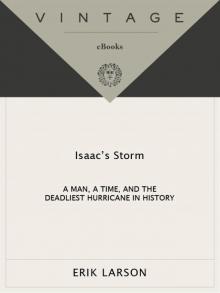- Home
- Erik Larson
Isaac's Storm: A Man, a Time, and the Deadliest Hurricane in History Page 2
Isaac's Storm: A Man, a Time, and the Deadliest Hurricane in History Read online
Page 2
Isaac harnessed his horse to a small two-wheeled sulky that he used mostly when hunting and with a gentle click of the reins set out for the beach three blocks south.
IT WAS A gorgeous morning, the breeze soft and suffused with mist, jasmine, and oleander. Stratus and cumulus clouds filled most of the sky, some bellying almost to the sea, but Isaac also saw patches of dawn blue rimmed with cloudsmoke. To his left, behind the clouds, the sun had begun to rise and at odd moments it turned the clouds orange-gray, like fire behind smoke. Seagulls hung in threes at fixed points in the sky where they rode head-on into the unaccustomed north wind, wing tips flinching for purchase. The wheels of Isaac’s sulky broadcast a reassuring crunch as they moved over the pavement of crushed oyster shells.
By now the most industrious children were rising to do their chores and get them out of the way so they could go to the beach as early as possible. Everyone reveled in the refreshing coolness. Rabbi Henry Cohen was awake and preparing for Saturday’s services. Dr. Samuel O. Young, an amateur meteorologist and secretary of the Galveston Cotton Exchange, was having breakfast and planning his own early-morning trip to the beach. At 18th Street and Avenue O½, in a small two-story rental house, Louisa Rollfing made breakfast for her husband, August, who was due downtown that morning to continue the painting of a commercial building. Louisa looked out the window and as always felt just a hint of disappointment, or maybe sorrow, for although she liked Galveston, she still was not used to the landscape. To her, palms and live oak did not qualify as trees. She missed the great green-black forests of her childhood home in Germany with trees “so old and large, that in some places it is almost dark in daytime.”
Visitors approaching Galveston from the sea saw it as a brilliant swath of light between sea and sky, like mercury floating on a deep blue plain. In the summer of 1900, a boy named John W. Thomason Jr.—later to become a well-known writer of military history—arrived to spend his vacation with his grandfather in a cottage off Broadway, half a dozen blocks from Isaac Cline’s office. “The Gulf breeze cooled the city at nightfall; one of the most beautiful beaches in the world offered delightful surf-bathing; and you saw everybody there in the afternoons, bathing, promenading or driving in carriages on the smooth, crisp sands.” He left town on Saturday, September 1, exactly a week before Isaac’s trip to the beach, very sad to leave. He looked back with longing as his train clicked over the long wooden trestle to the mainland and his newfound friends receded into the steam rising from Galveston Bay. “That city as it was,” he wrote, “I never saw again, nor some of the boys and girls I knew there.”
Where critics most faulted Galveston was for its lack of geophysical presence. The city occupied a long, narrow island that also formed the southern boundary of Galveston Bay, spanned by three railroad trestles and a wagon bridge. Its highest point, on Broadway, was 8.7 feet above sea level; its average altitude was half that, so low that with each one-foot increase in tide, the city lost a thousand feet of beach. Josiah Gregg, one of America’s most celebrated traveler-raconteurs, wrote in his diary in November 1841 of hearing about a past flood in which “this island was so completely overflowed that a small vessel actually sailed out over the middle of it.” He did not believe the story. He could see, however, that someday flooding might “even endanger lives.”
Regardless of one’s view, the fact was that Galveston in 1900 stood on the verge of greatness. If things continued as they were, Galveston soon would achieve the stature of New Orleans, Baltimore, or San Francisco. The New York Herald had already dubbed the city the New York of the Gulf. But city leaders also knew there was only room on the Texas coast for one great city, and that they were in a winner-take-all race against Houston, just fifty miles to the north. As of 1900, Galveston had the lead. The year before, it had become the biggest cotton port in the country and the third-busiest port overall. Forty-five steamship lines served the city, among them the White Star Line, which provided service between Galveston and Europe and in just over a decade would lose a great ship to hubris and ice. Consulates in the city represented sixteen countries, including Russia and Japan. And Galveston’s population was growing fast. On Friday, September 7, Isaac had read in the News the first brief report on the Galveston count of the 1900 census, which found that the city had grown 30 percent in only ten years.
Galveston now had electric streetcars, electric lights, local and long-distance telephone service, two domestic telegraph companies, three big concert halls, and twenty hotels, the most elegant being the Tremont, south of Isaac’s office, with two hundred ocean-facing rooms, fifty “elegant” rooms with private baths, and its own electric-power plant.
What most marked the city was money. As early as 1857 Galveston had achieved a reputation as a cosmopolitan town with a passion for fine things. One of its French chefs distinguished himself with a fusion of frontier and Continental cuisine that featured “beefsteak goddam a la mode.” By 1900, the city was reputed to have more millionaires per square mile than Newport, Rhode Island. Much of their money was vividly on display in the ornate mansions and lush gardens of Broadway, the city’s premier street.
The city offered everything from sex to sacks of Tidal Wave Flour. For the grieving rich, the giant livery and funeral works of J. Levy and Brothers offered a very special option: “A child’s white hearse and harness, with white horses.”
WINDOWS WERE OPEN in all the houses Isaac passed, and this imparted to the city an aura of vulnerability. Suddenly the noise of the sulky’s wheels seemed more jarring than reassuring. Ordinarily the great bathhouses at the end of the street would have brightened Isaac’s mood, but today they looked swollen and worn; they floated on cushions of greenish mist like castles from the mind of Poe.
Isaac drove until he had a clear view of the Gulf, then stopped the sulky. He stood, pulled out his watch, and began timing the long hills of water that rolled toward the beach. The crests of the waves were brown with sand, but on the surface between crests the spindrift laid intricate patterns of shocking-white lace.
Isaac knew the low-pressure center of the storm had to be somewhere off to his left, out in the Gulf. It was a fundamental tenet of marine navigation, one he explained during a lecture at the Galveston YMCA on a Saturday evening in 1891. Large crowds gathered for such talks. They consumed the spoken word the way later men would consume television. In the northern hemisphere, Isaac told his audience, the winds of tropical cyclones always move counterclockwise around a central area of low pressure. “Stand with your back to the wind,” he said, “and the barometer will be lower on your left than on your right.”
The swells came very slowly, at intervals of one to five minutes. To lay observers, this slow pace might have seemed reassuring. In fact, the slowness made the swells far more ominous, a principle Isaac only vaguely understood. Many years later he would write, “If we had known then what we know now of these swells, and the tides they create, we would have known earlier the terrors of the storm which these swells … told us in unerring language was coming.”
ISAAC TURNED HIS sulky around and headed back toward his office. The breeze was now head-on and ruffled the mane of his horse. The oyster-shell paving gave way to heavy wooden blocks and these imparted to the sulky a beat like that of a swiftly moving train. The north wind brought Isaac the perfume of a waking city: the clean, almost minty, smell of freshly cut lumber from the Hildenbrand planing mill; coffee from bulk roasters in the alley between Mechanic and Market; and always, everywhere, the scent of horses.
At the Levy Building, Isaac walked the three flights to the bureau, stopped inside for a moment, then continued up to the roof. To the east and south he saw the sea; to the west, the spires of St. Patrick’s Church, still under construction. The bureau’s storm flag, a single crimson square with a smaller black square at its center, rippled from a tower.
The barometer showed that atmospheric pressure had fallen only slightly from the night before. “Only one-tenth of an inch lower,” Isaac said.
Nothing in the sky, the instruments, or the cables from Washington indicated a storm of much intensity. “The usual signs which herald the approach of hurricanes were not present in this case,” he said. “The brick-dust sky was not in evidence in the smallest degree.”
Even so, the day felt wrong. Ordinarily, offshore winds kept the surf and tides down, but now, despite the brisk north wind, both the surf and tide were rising. It was a pattern new to Isaac.
He drove his sulky back to the beach. He again timed the swells. He noted their shape, their color, the arc they produced as they mounted the sand. They were heavier now and pushed seawater onto the streets closest to the beach.
Isaac returned to his office and composed a telegram to the Central Office in Washington. He ended the telegram: “Such high water with opposing winds never observed previously.”
Isaac’s concern was tempered by his belief that no storm could do serious damage to Galveston. He had concluded this on the basis of his own analysis of the unique geography of the Gulf and how it shaped the region’s weather. In 1891, in the wake of a tropical storm that Galveston weathered handily, the editors of the Galveston News invited Isaac to appraise the city’s vulnerability to extreme weather. Isaac, father of three, husband, lover, scientist, and creature of the new heroic American age, wrote: “The opinion held by some who are unacquainted with the actual conditions of things, that Galveston will at some time be seriously damaged by some such disturbance, is simply an absurd delusion.”
At the top of the Levy Building the anemometer spun. The wind vane shifted ever so slightly. The self-recording barometer etched another tiny decline.
FAR OUT TO sea, one hundred miles from where Isaac stood, Capt. J. W. Simmons, master of the steamship Pensacola, prayed softly to himself as horizontal spheres of rain exploded against the bridge with such force they luminesced in a billion pinpoints of light, like fireworks in a green-black sky.
He had stumbled into the deadliest storm ever to target America. Within the next twenty-four hours, eight thousand men, women, and children in the city of Galveston would lose their lives. The city itself would lose its future. Isaac would suffer an unbearable loss. And he would wonder always if some of the blame did not belong to him.
This is the story of Isaac and his time in America, the last turning of the centuries, when the hubris of men led them to believe they could disregard even nature itself.
PART I
The Law of Storms
The Storm
Somewhere, a Butterfly
IT BEGAN, AS all things must, with an awakening of molecules. The sun rose over the African highlands east of Cameroon and warmed grasslands, forests, lakes, and rivers, and the men and creatures that moved and breathed among them; it warmed their exhalations and caused these to rise upward as a great plume of carbon, oxygen, nitrogen, and hydrogen, the earth’s soul. The air contained water: haze, steam, vapor; the stench of day-old kill and the greetings of men glad to awaken from the cool mystery of night. There was cordite, ether, urine, dung. Coffee. Bacon. Sweat. An invisible paisley of plumes and counterplumes formed above the earth, the pattern as ephemeral as the copper and bronze veils that appear when water enters whiskey.
Winds converged. A big, hot easterly raced around a heat-induced low in the Sahara, where temperatures averaged 113 degrees Fahrenheit, heat scalded the air, and winds filled the sky with dust. This easterly blew toward the moist and far cooler bulge of West Africa. High over the lush lands north of the Gulf of Guinea, over Ouagadougou, Zungeru, and Yamoussoukro, this thermal stream encountered moist monsoon air blowing in from the sea from the southwest. The monsoon crossed the point where zero latitude and zero longitude meet, and entered the continent over Nigeria. Where these winds collided, they produced a zone of instability. The air began to undulate.
THE SEAS WERE hot. The land was hot. Throughout much of the United States temperatures rose into the nineties and often broke 100. Heat suffused the Rockies, Nebraska, Kansas, Missouri, Oklahoma, and a vast swath of country from the Gulf all the way to Pennsylvania. At 3:00 P.M. on Saturday, August 11, the temperature in Philadelphia hit 100.6 degrees. There was no air-conditioning. Trains were hot. Suits were black wool. Dresses were taffeta, mohair, gabardine. Carriages had black canvas tops, black-enameled bodies. Passengers roasted. Horses glistened. That same Saturday, thirty people in New York City died of heat prostration. Three children died when they fell from fire escapes where they had hoped to find a breeze. A high-pressure zone stretched from the Midwest far into the Atlantic and halted the flow of air over much of the nation. There was no breeze to find. “The air near the surface of the earth became superheated,” wrote Prof. E. B. Garriott, the Weather Bureau’s chief forecaster at the time. “Considered as a whole, the month of August, 1900, was the warmest August on record generally from the upper Mississippi Valley over the Lake region, Ohio Valley, and Middle Atlantic States.”
Which meant the heat embraced most of the nation’s population. Everyone shared in the suffering. What made the heat wave exceptional was not the maximum temperature recorded from city to city, but the sheer persistence of the heat. Springfield, Illinois, reported the longest hot spell in twenty years: twelve consecutive days with temperatures of 90 or higher. The men at Weather Bureau headquarters suffered deeply as the mercury hit or surpassed 96 degrees seven days in a row. In August, mean temperatures in Albany, Atlantic City, Baltimore, Chicago, Cincinnati, Erie, New York, and Philadelphia were the highest they had been since the bureau began keeping formal records in 1873.
In Galveston there was heat and rain. From mid-July to mid-August, a succession of tropical squalls swept from the Gulf and deluged Galveston. In one twenty-four-hour period, the city got fourteen inches of rain. Some streets flooded. Little boys converted tubs to boats and sailed downtown. A horse drowned. Total rainfall for that storm alone was sixteen inches in forty-eight hours, five inches greater than Galveston’s previous record set in September 1875 when a hurricane struck Indianola on Matagorda Bay, 150 miles down the Texas coast. In Paris, Texas, lightning demolished a tree. Ten billion joules of energy leaped to a porch ten feet away and knocked five children unconscious. Crickets swarmed Waco. The streets crunched. Bugs heaping under arc lights halted trolleys. Squads of citizens used unslacked lime and coal oil to drive the bugs away. The fire department deployed hoses.
The waters of the Gulf got hot.
OVER THE NIGER, the colliding winds veered and arced. Thunderstorms of great violence purpled the sky. A huge parcel of air began circling slowly, far too high for anyone on the ground to notice. The powerful Saharan wind swept it west toward the Atlantic as a wave of turbulence, thunderstorms, and driving rain.
Within this “easterly wave,” moisture-freighted air rose high into the troposphere, the first layer of sky and the realm where all weather occurs. The air cooled rapidly as it pierced colder and colder layers of atmosphere and encountered lower and lower pressure. The lower the pressure, the more the air expanded. As it expanded it cooled. It continued to rise but less than a mile above the earth crossed a threshold, and a phase change occurred. The air got so cold, it could no longer retain the water it carried. The vapor condensed en masse, as if at the tap of a conductor’s baton. The resulting droplets were so tiny they remained suspended in the rising air.
The updrafts pushed the droplets higher and higher at up to one hundred miles an hour. At four miles above the ground the droplets froze, and the rising air became filled with snowflakes and shards of ice. Men on the ground saw blossoms of cotton with flat gray bottoms that marked the altitude where condensation had begun. Children saw camels, rabbits, and cannon fire. The clouds bloomed before their eyes. Cells within grew and quickly expired. Some cells smoked into the sky like Christmas rockets. Others became massive Gibraltars of condensed water, Cumulus congestus; some rose higher, Cumulonimbus calvus. In the pillars that reached the top of the troposphere, temperatures fell to 100 degrees below zero. Tiny hexagonal m
irrors of ice drifted from the peaks in lovely translucent veils, or “virga.”
Something powerful and ultimately deadly occurred within these clouds. As the water rose and cooled and condensed, it also released heat. In the sky over Africa in August 1900, trillions upon trillions of water molecules began breathing tiny fires. This heat propelled the air even higher into the atmosphere until the cloudtops flattened to form Cumulonimbus capillatus incus. Incus meaning “anvil,” the name too of an anvil-shaped bone in the human ear. These were thunderheads. “Convection.” Higher up, the strongest clouds penetrated the stratosphere. Soon an army of great thunderheads was marching west along the horizon, watched closely by the captains of British ships sailing down the African coast with fresh troops for the Boer War. Seventy to eighty such waves drifted from West Africa into the Atlantic every summer, some dangerous, most not. The captains knew them less as weather, more as geography—something to watch to fill the long hours at sea. At dawn and dusk, the distant clouds warmed the sky with color. Rain smudged from their bottoms in fallstreaks. Frozen virga drifted from their glaciated tops. When the light was just right or a squall was near, the clouds formed an escarpment of black. Frigate birds sidelit by the sun drifted in the foreground and flecked the sky with diamond.
Ships directly in the path of the August wave got a different view. Each wave had a “period” of four days, meaning a ship in a fixed location would experience a cycle of weather that repeated itself every four days. On the first day the air was hot and dry, like a desert at sea. No clouds, but also very little blue sky. The only blue was directly overhead. Everywhere else the sky was white, the horizon like milk—all of this caused by dust carried from the deserts of Africa.

 Lethal Passage: The Story of a Gun
Lethal Passage: The Story of a Gun In the Garden of Beasts: Love, Terror, and an American Family in Hitler's Berlin
In the Garden of Beasts: Love, Terror, and an American Family in Hitler's Berlin Dead Wake: The Last Crossing of the Lusitania
Dead Wake: The Last Crossing of the Lusitania The Splendid and the Vile
The Splendid and the Vile Thunderstruck
Thunderstruck Isaac's Storm: A Man, a Time, and the Deadliest Hurricane in History
Isaac's Storm: A Man, a Time, and the Deadliest Hurricane in History In the Garden of Beasts
In the Garden of Beasts The Devil in the White City
The Devil in the White City